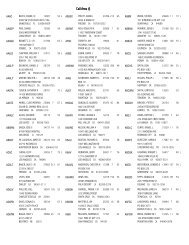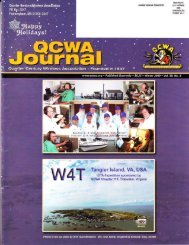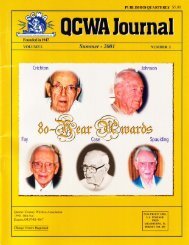ASHLAND, MA PEBMIT NO.7 - Quarter Century Wireless Association
ASHLAND, MA PEBMIT NO.7 - Quarter Century Wireless Association
ASHLAND, MA PEBMIT NO.7 - Quarter Century Wireless Association
Create successful ePaper yourself
Turn your PDF publications into a flip-book with our unique Google optimized e-Paper software.
Bill Katz, WqPPH (L) receiving his award!<br />
of the QCWA Chapter in northern California.<br />
Bill Katz. WgPPH<br />
I grew up in Wilmette, lllinois, in the years<br />
prior to the great stock market crash in<br />
1928. When I was I0 or 11, I put together a<br />
receiver from a galena crystal, a cats'<br />
whisker, and a telephone earpiece "bor-<br />
rowed" from the phone company. One<br />
evening I picked up KDKA in Pittsburgh. ln<br />
great excitement I called my Dad in. He lis-<br />
tened, and said, tapping his forehead, "l<br />
believe it up here" but, tapping his chest<br />
over his heart, "l don t believe it down<br />
herel"<br />
I learned Morse code around 1929 or<br />
1930 as part of the requirements for a Boy<br />
Scout merit badge. The bedroom of a next<br />
door neighbor's son, also in the same scout<br />
troop, faced mine. So we ran bell wire<br />
across, hooked up a battery, a buzzer and a<br />
crude key, and learned the alphabet suffi-<br />
ciently to get those badges.<br />
ln 1930 I entered New Trier High School<br />
in Winnetka, and lo and behold they had a<br />
ham radio club which I eventually joined. My<br />
Elmer was a year ahead of me, Jim Ricks,<br />
then W9DHH, who became a good friend,<br />
and a frequent Ping Pong opponent. Jim,<br />
now a Silent Key, obtained the call K9T0<br />
and is known as the developer of the T0<br />
Keyer, one of the first automatic keys. Under<br />
his encouragement and tutelage, I passed<br />
the code and theory exam and was licensed<br />
as W9PPH in 1933. My first rig was "bread<br />
board" with a crystal con-<br />
trolled Haftley oscillator and a<br />
pair of 210s in push-pull run-<br />
ning 600 volts to the plates.<br />
This fed a Zepp antenna<br />
stretched between two trees<br />
in our back yard. The ladder<br />
line feeding the antenna wenl<br />
through holes in the window.<br />
My first receiver was a<br />
National SW-3; I sure wish I<br />
had that in my possession<br />
n0w.<br />
No VFO is those days.<br />
You got a crystal, put out a<br />
call on some set frequency,<br />
and tuned around the band looking for a<br />
response from some other crystal controlled<br />
frequency.<br />
My CW contacts were mostly on 40 meters,<br />
with an output power of around 50 watts.<br />
My first contact (l still have my logbook)<br />
shows a response to my CQ from W9MVU in<br />
nearby Evanston on January 6, 1 934. Next<br />
day I worked W2CBT in New Jersey. The<br />
ensuing days I worked many US stations,<br />
and called many DX stations with no reply.<br />
Finally, on February 20, I called and worked<br />
VE3WD in Hamilton, Ontario, - my first out<br />
of US contactl 0n March B I called and<br />
worked CMl PW in Guanajay, Cuba.<br />
I built an AM phone transmitter - a single<br />
58 using suppressor grid modulation. My<br />
first phone "DX" was on 160 meters to<br />
W9GES in the neighboring town of<br />
Kenilworth!<br />
0f course, all ham activity stopped during<br />
the war. After the war, we returned home in<br />
1947 and purchased a new home in<br />
Highland Park. I met Mike Bexter, W9FKC,<br />
who became a friend and sort of second<br />
Elmer. I retook the amateur exam and was<br />
able to get my old call back, which l've had<br />
ever since,<br />
ln .1990 we sold the house - the kids<br />
were grown and gone and moved into a<br />
condo. That has confined me entirely to<br />
mobiling still with a YAESU transceiver and a<br />
4-foot bumper mounted antenna. An lCOM<br />
2-6 meter transceiver and an lC0M hand-<br />
held round out the equipment set,<br />
Some time ago I called up the local Notlh<br />
Shore Radio Club 2-meter repeater from my<br />
car, entered the node for Las Vegas, and<br />
after checking for anyone using it, put out a<br />
call. "This is W9PPH near Chicago - anyone<br />
listening?' Back came a reply from the<br />
North Slope in Alaska. Here I am sitting in<br />
my car, with 5 watts output, an 1B-inch<br />
antenna, talking to the North Slope. WOW! I<br />
know how it works but, "l believe it up here.<br />
but I don't believe it down herel"<br />
Joe LaManna, W6HPE<br />
I was born in New York City but the family<br />
moved to NJ when I was a baby. My interest<br />
in radio started when reading a NY paper<br />
which had a radio page - n0, n0 programs,<br />
but schematics and information on building<br />
crystal sets. That added to my interest when<br />
I built an oatmeal box coil, slider and galena<br />
crystal detector. The magazine, "Short Wave<br />
Craft" led to a 1-tube SW receiver and a<br />
stray copy of a 1920 QST led to ham radio.l<br />
struggled with code for years and finally got<br />
enough nerve to take and pass the test. I<br />
was ticketed as W2HPE by the FCC - one of<br />
the first calls by the FCC, which had been<br />
FRC until 1934.<br />
All of my ham gear, pre-war ll, was home<br />
brew. Discarded battery radios were a good<br />
source of pafts as AC radios were coming<br />
on the market. My early activity was mainly<br />
B0 meter CW with 5 meter and 2112 meler<br />
fone.<br />
I joined the US Naval Communications<br />
Service in I937 as a Radioman, I served on<br />
summer training cruises and was called to<br />
active duty in 1940. My service was as a<br />
radio operator on an aviation patrol<br />
squadron and radio maintenance technician.<br />
After attending Naval Air Technical Training<br />
School, I transferred to a Naval Air Transport<br />
Squadron, all stateside.<br />
After movrng to California in 1955, I went<br />
to work for Douglas Aircraft. Co., first, as a<br />
technician, then as an electrical engineer on<br />
aircraft and missiles.<br />
This move required that my license be<br />
reissued as W6HPE. I maintained contact<br />
with one of my friends back in Ridgefield<br />
Park, NJ, on .15 and 20 meters CW. Other<br />
friends joined us through the years - from<br />
Washington, Florida, Guatemala and<br />
QCWA Journal . Summer 2OO9 . w\A/w,qcwa,org



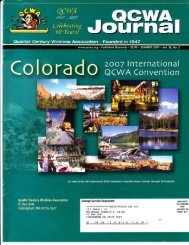
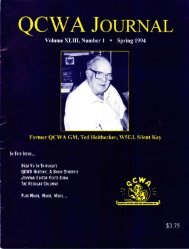
![11{J hI EfifSIt]E I]E - Quarter Century Wireless Association](https://img.yumpu.com/11816560/1/190x245/11j-hi-efifsite-ie-quarter-century-wireless-association.jpg?quality=85)
